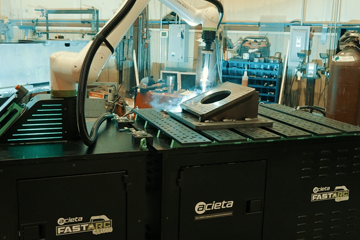
Industries that rely on experienced welders are about to experience a significant labor shortage. Many will need technological and automated solutions to maintain productivity and profitability.
More than 400,000 people work in the U.S. welding trades, with a high employment concentration in manufacturing, according to the Bureau of Labor Statistics. The average age of an employee in the American workforce hovers around 42 years old — but welders are an older group, at about 55 years old. An aging workforce and a persistent shortage of talented people are expected to drive a welder shortfall upwards of 375,000 in the next few years, according to the American Welding Society.
The inability to hire qualified welders, solderers, cutters and brazers could cut manufacturing productivity, particularly in the Midwest. Fortunately, the advanced technology being deployed in welding cobots is helping to close the gap.
What Are Welding Cobots?
The term “cobots” describes the use of collaborative robot welding machinery that automates the process. A collaborative welding robot typically consists of a mechanical arm, power resource, welding torch, cooling method and a programming system. When mounted on a work bench, welding cobots can be programmed to handle repetitive tasks with precision accuracy. They can also be cart-mounted or secured via powerful magnets, making them mobile tools. These industries are successfully onboarding automated welding systems:
- Aerospace and defense
- Automotive manufacturing
- Mining and construction
- Oil and gas sectors
- Rail and shipping
- Wind turbines
Welding automation has also emerged as a key component in the manufacturing of electric vehicles. State-of-the-art facilities are designing fabrication and assembly lines with the latest technological advancements, including welding cobots.
It's important to understand that collaborative robot welding does not necessarily replace human beings. Instead, the automated systems handle sometimes hazardous tasks while a technician may oversee multiple welding cobots.
What Are the Benefits of Welding Cobots?
The next-gen innovation employed in cobots for welding allows skilled welders and technicians to work alongside the machinery. Under this scenario, companies maintain or increase their productivity even as the number of hand-held welding professionals declines. Not only does the application of collaborative robot welding offset the labor shortage, but it also helps buoy American employment. These are other leading reasons why industry leaders gain by investing in welding automation:
- Improve consistency: The welding arm of a cobot never gets tired or loses its precision focus. Welding cobots constantly produce accurate and reliable joints. They only pause their steady productivity when a technician shuts them down.
- Reduce waste: The cost of materials used in manufacturing has dramatically spiked in recent years. Manual welding generally results in fabrication errors and wasted materials. This was previously considered the “cost of doing business,” but automation removes waste from the equation. Accurately programmed welding cobots can help maximize the use of materials inventories.
- Worker safety: One of the driving reasons for the growing welder shortage may involve injuries. Welders suffer burns, UV exposure, arc flash and exposure to toxic fumes. Deploying cobots for welding tasks allows the controller to remain at a safe distance. As a safety measure, automation helps meet OSHA regulations and reduce workers' compensation claims.
Companies generally have someone with TIG or MIG experience to help spearhead a collaborative welding robot system. Once an automated approach has been established, workers outside the welding trades can be trained to run its operation. As the labor shortage becomes critical, proactive industry leaders in high- or low-volume shops won’t necessarily be negatively impacted.
Why Invest in Collaborative Robot Welding
Investing in a collaborative welding robot system continues to deliver cost-effective benefits. The price of a new cobot welder may be comparable to the salary of a single skilled employee. Key differences such as not calling out sick, taking a vacation or uneven productivity make automated machinery attractive. In terms of actual dollars, a welding cobot doesn’t draw a salary week after week, year after year. Once the initial investment has been satisfied, companies add to their profit margins.
Acieta Delivers Reliable Cobot Welding Solutions
As North American manufacturers continue to grow and reshore operations, automation will play a key role in their success. At Acieta, we provide collaborative robot welding solutions designed to increase workplace efficiency, precision and safety. If you are experiencing a hiring crunch or want to improve productivity, contact us and let’s get the process started.